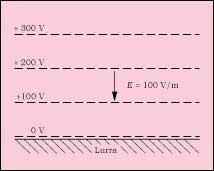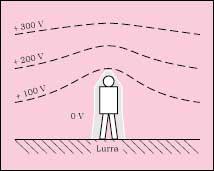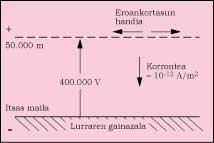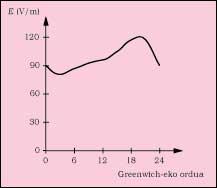Atmofera electricity. Rays and others
In this article and in the so-called “What to do in case of storm?” which will appear in the following number, we will analyze this typical phenomenon of nature.
When analyzing electricity in the atmosphere, we will refer to a phenomenology still unknown, in which one of the gaps of this supposed ignorance of physicists appear. In my opinion, from the point of view of teaching it is interesting to do so to consciously refer to the limits of knowledge, since on more than one occasion students consider the knowledge of Physics as something done and finished. On the other hand, when performing the theoretical analysis of Physics in the subjects of the Faculty, we are used to using simplified models and, for example, in the field of Electricity are usually considered spherical or cylindrical conductors, or linear currents. In addition, for the simplification of the mathematical model, finite bodies are usually analysed or with very simple geometric shapes, often with geometric symmetries, which makes calculations much easier.

However, the phenomena that appear in reality are usually much more complicated and bodies do not have to have known and symmetrical geometric shapes. Something like this happens with atmospheric phenomena, which are very complicated and move away from simple mathematical models. On more than one occasion we are only able to make an approximate qualitative explanation of phenomena in these cases. Of this type, for example, the problem we have with some electrical phenomena in the atmosphere, and more specifically with respect to the rays that occur in the attacks of thunder.
In this work, starting from the historical memory of the study of the subject, we will try to perform an analysis of some of the main electrical phenomena that take place in the atmosphere, but aware that they are not yet fully understood.
Historical memory Historical memory
The fear and panic of the attacks of thunder and the consequences of the rays has always been humanity. To this can be mentioned the myths of many countries, in which on many occasions the god of the rays of great breaking power appears. However, myths give us an inadequate explanation for Physics.

The reference and scientific study of the relationship between lightning and electricity is a matter of recent centuries, since we began to study questions related to electricity. The first mention of this connection was made by WALL (1708), who, after observing the waterfalls and illuminations between his fingers and the amber loaded, suggested «who apparently represented the process of thunder and rays». Subsequently, the scientist GRAY (1735) presented a similar opinion on the observation of electric fire, and winkler (1746) made a detailed comparison between the electric arc and the lightning discharge.
The first experiments on the electricity of thunder clouds were conducted around 1750. By then he had already invented the Leyden pitcher, which served to store and store the electric charge, and Franklin tried to get electricity from thunder clouds, isolating a point from the ground in an old tower. Although the name of Franklin has reached us, it seems that the first to achieve it was D’ALIBARD (1752), isolating for it the long iron stick (~ 13 m) with a glass bottle and maintaining the wooden supports (the day of the positive results was 1752-V-10).
A month later, Franklin conducted the test with a cable kite, which also obtained positive results. From there came other experiments until they reached the invention of the lightning conductor. It must be said that in them there was no serious accident, since in all cases the sources of current were the discharge premises of the small regions of clouds and not the true rays. The same did not happen in 1753 in St Petersburg, where Professor RICHMANN died by catching the true ray to the driver of his experiment.
Electrical potential in the atmosphere

Let's start by presenting the results of the measurements of atmospheric electricity. Taking into account the average values, in a plain territory or over the sea, when ascending the electric field potential increases, with an approximate gradient of 100 V/m. That is, the value of the electric field E is 100 V/m, with vertical direction and descending direction
As can be seen in the figure, the terrestrial surface behaves as a conductor, with negative load, forming an equipotential surface and the rest forming nearby concentric spheres. However, when on the surface there are irregularities (or persons), in the scheme described above appear deformations. In fact, in our case, it can be interesting to analyze what happens. At first glance, from the above, we can think that there is a great difference of potential between ourselves and the feet (~ 170 V depending on the height of the person). But things do not happen like this. In fact, the human body is a sufficient conductor, so in contact with the soil there is a tendency to reach the same potential, that is, to form a surface equipotential with the terrestrial surface. Accordingly, the surrounding equipotential surface appears deformed, as shown in figure 2.
In this work we will not talk about the methods of measuring the atmospheric electric field, for what we can start from the reference. However, when going up this area is getting slower and slower, being very small when reaching 50 km. In principle, the potential is increasing to that height, with a difference of potential between local and surface points of 400,000 V, as shown in Figure 3. According to its scheme, we can consider it as a positive upper layer and the lower as negative.
However, as we will see in the next section, there is a vertical current that, taking into account the totality of the Earth, is worth 1.800 A. Consequently, it can be thought that over time the discharge of the upper layer will occur and that eventually the two potentials will be matched. But things are not so, and that difference of potential is quite persistent, despite the minimal incidences. Moreover, the aforementioned incidents have a great regularity with a frequency of one day. In fact, global measurements indicate that the average evolution of the electric field throughout the day is shown in Figure 4. As can be seen, the maximum value is around ± 15%, measured at 7 pm and the minimum at 4 am (Greenwich time). Perhaps the highlight is to know that similar results are obtained in any region of the Earth, at the same time as in Greenwich.
Electrical conductivity of the air. Electric currents in the atmosphere

Although the air is insulating in itself, the measurements in the atmosphere indicate that, in addition to the electric field, there is current in vertical direction, being its very low current density (of the order of 10-12 A/m2). Where does that conductivity come from?
In fact, there are several ions in the air, formed by different origins. In short, two are the main ways to produce ions in the atmosphere. What was first understood is by radioactivity. On the terrestrial surface and in the atmospheric dust there are a series of natural radioactive elements, and the particles of great energy that are generated in their decay have the capacity to ionize air molecules. However, the ionization by radioactive elements is less and less with height, since most radioisotopes are found in the soil or in the surrounding dust. However, measurements in balloon indicate that the ionization per unit of volume increases depending on the height.
These measures are XX. They were celebrated in the first twenty years of the twentieth century and surprised physicists, who, without an adequate explanation, believed that it should be the opposite. The explanation came from the hand of a new unknown phenomenon, the discovery of cosmic rays. Today we know that cosmic rays come from outside the Earth, and the higher up into the atmosphere, the more its influence is felt. Thus, cosmic rays are the other motor of the continuous formation of ions and the cause of their number being greater and greater.
It is also necessary to make an observation on the nature of the ions. On the one hand, we have ions created by ionization of the air molecules, which we can call “small” ions, but we also have to take into account others. They also float dust or impurities in the air, which can also be charged by forming “large” ions. For example, because of the waves of the sea can reach the atmosphere drops of water very small that when evaporating can remain small crystals of NaCl floating in the air. Loaded with such crystals, we have some “big ions”. Of course, small ions move much faster than large ions.

In any case, the conductivity of the air, based on the mobility of the ions, is increased according to the height of the terrestrial surface, for two consecutive reasons. In the first place, because the ionization caused by the cause of cosmic rays is increasing depending on the height and, in the second place, because the density is decreasing, because the intersecting pathways of the ions are increasing, increasing the conductivity.
At 50 km of height there is a great conductivity that in practice can be assimilated to that of a conductor in this layer. From this height we can consider that the potential area is not altered, as indicated above in figure 3. As a note, despite having a high degree of ionization, this layer should not be mixed with the so-called ionosphere. The ionosphere starts at about 100 km of height, being the main generation of local ions the photoelectricity produced by the solar rays, and with a curious characteristic the reflection of the radio waves, which allows the propagation of the radio emissions, which allows to drive the radio waves. In any case, returning to the layer of about 50 km, the high conductivity in horizontal direction places us in the understanding of uniformity across the Earth shown in figure 4, considered as a conductive layer of the entire globe, since it tends to equalize rapidly the potential.
However, while we have somehow clarified the reason for uniformity of potential, it has not yet been explained. In particular, as indicated above, although the density of current towards the terrestrial surface is very low, since its surface is very high, the average current from the upper layer to the terrestrial surface is about 1,800 A. Therefore, with a potential difference of 400,000 V, we have a continuous power of about 720 MW. A question can come to us immediately. If this continuous current runs without renewal, the load of the upper layer would soon disappear, paralyzing the process. How is it possible not to download the top layer? Where is the “machine” or “battery” that keeps the process running continuously? According to existing theories, the surface (+)/top layer (-) appears to be constantly recharging the system, being the axis and essence of the charging process in thunder rays.
Process of charge by lightning

According to the measurements made, during the fall of the rays negative charges are passed to the terrestrial surface in most cases (nine of every ten). Thus, due to the aggressions of thunder that are taking place throughout the entire planet Earth, the earth's surface is constantly being loaded with an average current of 1,800 A, a charge that is constantly being unloaded throughout the day in regions of good time, with an approximate current density of 10-12 A/m2 mentioned above, maintaining a daily balance (with increases according to the process described in figure 4).
How many attacks of thunder occur in the world? It is not easy to give concrete data in this regard, among other things, because it is not possible to carry out a direct observation in most regions, such as in the seas that cover most of the terrestrial surface. On the other hand, the highest intensity of thunder attacks in the tropical regions is known. In any case, estimates of different types have been made, according to which in the whole Earth about 100 rays fall on average per second, being its greatest activity around 7 pm (Greenwich time), according to the explanation of figure 4 above. Apparently, when performing each ray in approximately 20 Coulomas, you can explain the value of the charging current of the system.
Note: Note: To view the images in PDF format.





